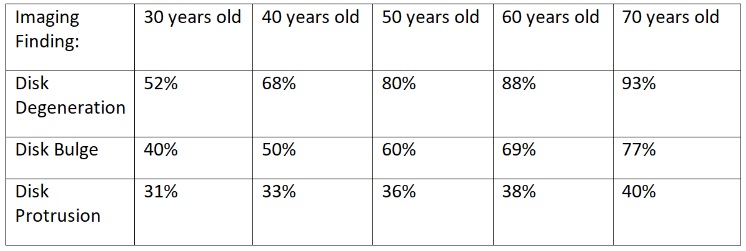On Wednesday, April 24, 2024 from 5:30pm-6:30pm, we are hosting a FREE Shoulder Pain Workshop [ Online
] - Click here for more info
September 18, 2022

By: Dr. Mary Rose Strickland, PT, DPT, OCS
There has been a plethora of research that has come out in recent years that shows that images (xrays or MRIs) in many cases do not identify the source of symptoms. Often times, these images show normal, age-related changes. Degeneration, spurs, arthritis are for the inside of our body the same that wrinkles and gray hair are for the outside. This has led to a lot of confusion and further questions. “Then why even bother with imaging?” and “how are you going to treat me, if you don’t have a picture?” and most importantly: “so WHY do I hurt?”. To understand this all, let’s start with research (just don’t take my word for it…)
A study from the American Journal of Neuroradiology in 2015 shows that by the ages below, the following pathologies were found in % below of ASYMPTOMATIC (meaning no pain, no symptoms) individuals:

Additional studies have shown the following based on body region:
Imaging can be useful to rule out more serious pathology – including a broken bone, extreme interruption to nerves from the spine, tumors/cancer, potential indication of other systemic joint disease, etc. It does not tell us how to treat a condition.
“So what is the point of an image?”
Imaging can be useful to rule out more serious pathology – including a broken bone, extreme interruption to nerves from the spine, tumors/cancer, potential indication of other systemic joint disease, etc. It does not tell us how to treat a condition.
There are clinical indicators that help determine when an image is needed up front. For majority of musculoskeletal disorders, imaging is not needed to determine course of treatment. It only is required if the course of treatment will change based on result of the image. Often times, physical therapy is the most appropriate first step in care. If after 6-8 weeks of conservative treatment you are not seeing results, then an image may be indicated at that time.
“How are you going to treat me without an image?”
We have clinical tests that we can group together and provide us with the most accurate (although not perfect) information to classify and identify how we should go about treatment. Once more serious pathologies are ruled out, we determine what classification you fall in to and then are able to treat you based on that information; no image needed!
“Why Do I Hurt?”
At this point you have learned that a picture does not often tell us why you hurt, due to the fact that findings that seem “abnormal” may be completely normal after all. Or they may be from previous injuries or issues we have had in years’ past. We are a dynamic system with many tissue structures that move in three dimensions at many different joints. Often times if we have pain it is caused by an imbalance in that system. For example, your foot pain while walking may be the result of your hip not extending well and putting added stress on your foot. Walking is a dynamic activity, involving multiple joints. A picture of just the foot in standing (static – no movement) position does not give us the information we need. Also more chronic pain can be caused by heightened sensitivity of the nervous system. Think of your motion-detected flood light that is supposed to turn on when someone walks by and instead it turns on when a leaf blows by because it is too sensitive. This hypersensitivity is another example of a cause of your pain that does not show up on an image.
Cost Implications
Based on your specific region, the facility you go to, and the specific body region, the average x-ray can cost up to $800. MRI on average costs $3,000. A full course of physical therapy will cost $2,000 from the average hospital, and often much less (around $1200) from a local private practice.
Bottom Line
See your physical therapist first. They can help determine if an image is needed or not. They will serve as a great consult for your ache, pain or injury and/or refer you to more formal physical therapy if that is appropriate. Research shows that those who choose PT first have better outcomes and lower cost of care. Now you can understand why…it is about getting the right care at the right cost at the right time!